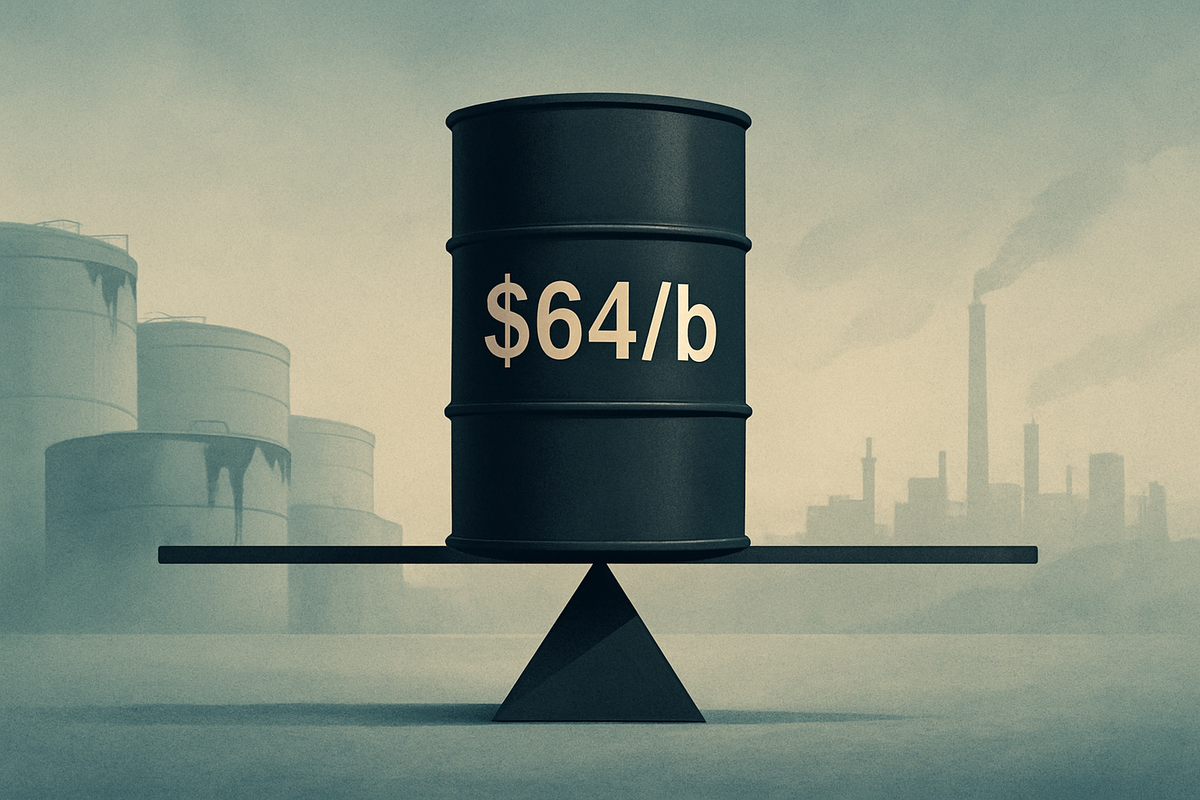
London, November 5, 2025 – The global crude oil market is experiencing a period of delicate equilibrium, with Brent crude oil futures easing towards the $64 per barrel mark and trading within a remarkably tight range. As of November 5, 2025, Brent crude (ICE:BRN00) is hovering around $64.23/b, reflecting a complex interplay of persistent oversupply, softening global demand, and strategic, albeit cautious, maneuvers by major producers. This stability, while offering some relief to energy consumers, signals a deeper market rebalancing and poses significant challenges for oil-exporting nations and upstream producers.
The current price environment marks a notable shift from previous periods of volatility, suggesting that the market is grappling with a fundamental imbalance where global supply is projected to outpace demand. This subdued performance, with Brent down from previous sessions and year-on-year, underscores a prevailing "risk-off" sentiment in financial markets and highlights the growing influence of non-OPEC+ production on global pricing dynamics.
Market Stability: A Confluence of Supply Surges and Demand Deceleration
The easing of Brent crude towards $64/b and its subsequent tight trading range is a culmination of several critical developments over the past year. A primary driver has been the significant deceleration in global oil demand growth, particularly from major importers like China. In early 2024, global oil demand growth slowed markedly, with China's consumption increasing by only 180,000 barrels per day (bpd), a stark contrast to earlier projections. By mid-2025, China's total crude oil consumption even saw a year-on-year drop, attributed to a broader economic slowdown, rapid electric vehicle (EV) deployment, and an expanding high-speed rail network. The International Energy Agency (IEA) has consistently revised down its demand forecasts, citing a "harsher macro climate" and transport electrification as key dampening factors.
Simultaneously, robust non-OPEC+ supply growth has significantly contributed to the overall supply glut. The United States (NYSE: XOM, NYSE: CVX), in particular, has continued to set oil production records, averaging 13.2 million bpd in 2024 and on track for 13.5 million bpd in 2025, despite a slowing growth rate compared to peak shale boom years. Other non-OPEC+ producers such as Brazil, Canada, and Guyana are also contributing substantial additions to global supply. This surge in supply, coupled with accumulating global oil inventories reaching a four-year high by August 2025, has exerted consistent downward pressure on prices.
OPEC+ (including Saudi Arabia, Russia, and UAE) has played a crucial, albeit complex, role in attempting to manage this oversupply. After extending voluntary production cuts through 2024, the alliance agreed in March 2025 to begin gradually reversing 2.2 million bpd of these cuts over an 18-month period, starting April 2025. However, acknowledging weakening demand, OPEC+ later agreed to a modest output increase for December 2025 but crucially decided to pause further hikes for the first quarter of 2026. This adaptive strategy demonstrates their intent to prevent a sharp price collapse while navigating internal pressures from members needing higher revenues. Geopolitical tensions, while ever-present, have seen moments of easing, such as reduced fears of a major escalation in the Middle East in late 2024, which also contributed to price declines.
Corporate Fortunes: Winners and Losers in a $64/b World
A stable Brent crude price of $64/b presents a mixed bag for public companies, creating clear beneficiaries and those facing significant headwinds. The predictability offered by a tight trading range allows for more accurate financial planning, but the moderate price level itself dictates profitability.
Potential Winners:
- Airlines: Companies like American Airlines (NASDAQ: AAL), United Airlines (NASDAQ: UAL), Delta Air Lines (NYSE: DAL), and Southwest Airlines (NYSE: LUV) stand to gain significantly. Fuel is a major operating expense, and lower, stable jet fuel costs directly translate to improved profit margins. This allows for increased investment, fleet upgrades, or enhanced shareholder returns.
- Shipping Companies (Non-Oil Tanker): Firms such as Maersk (CPH:MAERSK-B) and Hapag-Lloyd (XTRA:HLAG) will benefit from reduced bunker fuel expenses, which can constitute 30-50% of their operating costs. This leads to better profitability and potentially more competitive freight rates.
- Automotive Industry: Automakers like Ford (NYSE: F) and General Motors (NYSE: GM) could see a boost. Lower gasoline prices increase consumers' discretionary income, potentially stimulating vehicle sales, especially for larger, higher-margin SUVs and trucks.
- Chemical Companies: Producers such as BASF (XTRA:BAS) and Dow (NYSE: DOW) rely heavily on petroleum-derived feedstocks. Stable, lower crude prices reduce raw material and energy costs, widening profit margins for commodity and specialty chemical producers.
- Consumer Discretionary Sector: Reduced fuel costs act as a "tax cut" for consumers, increasing disposable income. Retailers like Walmart (NYSE: WMT) and hospitality giants like Marriott International (NASDAQ: MAR) could see increased spending.
Potential Losers:
- Upstream Oil and Gas Exploration & Production (E&P) Companies: Pure-play E&P firms, particularly those with higher production costs or significant exposure to unconventional resources like some US shale producers (e.g., smaller independents), will face substantial pressure on profit margins. A $64/b Brent price is below the breakeven point for some higher-cost operations, leading to reduced capital expenditure and potential production cuts.
- Oilfield Services Companies: Providers like Schlumberger (NYSE: SLB), Halliburton (NYSE: HAL), and Baker Hughes (NASDAQ: BKR) are directly impacted by E&P companies' spending cuts. Reduced drilling and completion activity translates to lower demand for their specialized services, affecting revenues and profitability.
- Oil Tanker Shipping Companies: Companies such as Euronav (NYSE: EURN) and Frontline (NYSE: FRO), specializing in crude oil transportation, may experience reduced trade volumes due to lower demand and increased regionalization of supply. This could lead to excess capacity and lower freight rates.
- Oil-Exporting Nations and State-Owned Oil Companies: While not always publicly traded in the same manner, national oil companies and countries heavily reliant on oil export revenues (e.g., Saudi Aramco (TADAWUL:2222)) will see reduced government coffers and face fiscal challenges, necessitating budget adjustments and accelerated economic diversification efforts.
Wider Significance: A New Energy Paradigm Emerges
The current stability of Brent crude at $64/b is more than a momentary market snapshot; it reflects profound shifts in broader industry trends and carries significant wider implications. This price point fits into a narrative of an anticipated supply glut driven by robust non-OPEC+ production, particularly from the US, coupled with a structural slowdown in global demand growth. The IEA and other agencies consistently forecast an oversupplied market through 2026, with global oil supply potentially exceeding demand by over 1 million bpd in 2025.
The ripple effects are extensive. For upstream oil companies, the sustained lower price environment necessitates a focus on cost efficiency and portfolio optimization, prioritizing "advantaged projects" with lower break-even costs. Downstream sectors, including refining and petrochemicals, conversely benefit from cheaper feedstock, potentially bolstering their margins. Oil-exporting nations face increasing pressure to diversify their economies away from oil dependency, as reduced revenues strain national budgets and necessitate fiscal reforms. Oil-importing nations and consumers, however, enjoy an economic boon through reduced energy costs, acting as a mild stimulus to economic activity.
From a regulatory and policy standpoint, OPEC+'s cautious production management strategy is a direct attempt to stabilize the market. However, the effectiveness of these interventions is increasingly challenged by the surge in non-OPEC+ supply. Ongoing international sanctions against major producers like Russia and Iran continue to influence global supply dynamics, often contributing to the overall glut as discounted oil seeks new buyers. Historically, periods of sustained low oil prices have tended to discourage investment in new production, potentially setting the stage for future supply shortages when demand inevitably recovers. This current phase could therefore be a precursor to future volatility, even if the immediate outlook is one of stability. The accelerating global energy transition also looms large, with government commitments to decarbonization and the rapid adoption of EVs exerting long-term pressure on fossil fuel demand.
What Comes Next: Navigating a Bearish Horizon
The immediate future for the crude oil market, extending through the remainder of 2025 and into 2026, appears to be characterized by continued downward price pressure and rising inventory levels. The EIA projects Brent to average $62/b in Q4 2025 and potentially fall to $52/b in 2026, while the World Bank anticipates averages of $64/b in 2025 and $60/b in 2026. This bearish outlook is underpinned by robust non-OPEC+ production growth from the US, Brazil, Guyana, and Canada, coupled with moderating global demand influenced by a "harsher macro climate" and the accelerating energy transition.
In the long term, the crude oil market will be profoundly shaped by the global energy transition. While Goldman Sachs forecasts oil demand to continue growing for another decade, primarily driven by emerging markets and hard-to-decarbonize sectors like air travel, the overarching trend is towards lower carbon intensity. This necessitates significant strategic pivots for key players. Oil producers must prioritize cost efficiency, optimize portfolios, and strategically diversify into renewables and lower-carbon technologies. Oil-dependent nations must accelerate economic diversification and fiscal discipline. Governments of consuming nations might seize the opportunity of lower prices to replenish strategic petroleum reserves and implement energy policy adjustments like reducing subsidies or imposing carbon taxes.
Market opportunities may emerge from lower fuel costs stimulating global economic activity, strengthened downstream refining and petrochemical segments, and potential industry consolidation. However, significant challenges persist, including the risk of a persistent oversupply, weakening global demand, and the inherent price volatility driven by geopolitical events and policy decisions. The fiscal strain on oil-dependent economies and potential financing constraints for conventional oil and gas projects also remain critical concerns.
Comprehensive Wrap-Up: A Market in Transition
The Brent crude oil market, currently easing towards $64/b and trading in a tight range as of November 5, 2025, is unequivocally in a state of transition. The key takeaway is a market fundamentally characterized by oversupply and subdued demand, a dynamic that is exerting consistent downward pressure on prices. While OPEC+ is attempting a delicate balancing act with cautious production management, the robust and growing supply from non-OPEC+ producers, particularly the US, combined with a softening global economic outlook and the accelerating energy transition, paints a predominantly bearish picture for the coming months and years.
Moving forward, the market is likely to remain volatile, albeit potentially within a lower trading range than seen in recent years. This environment weakens OPEC+'s pricing power and highlights the increasing importance of non-OPEC+ supply. The lasting impact will be a continued re-evaluation of investment strategies across the energy sector, with a greater emphasis on cost efficiency, diversification, and resilience to market shifts.
Investors should remain highly vigilant. Key indicators to watch include: OPEC+ policy shifts (any deviations from planned production adjustments), global demand recovery (macroeconomic data from China, Europe, and other major consumers), US inventory reports, non-OPEC+ supply growth (especially from the US, Brazil, Guyana, and Canada), geopolitical developments (particularly those affecting major oil-producing regions), and US dollar strength and monetary policy (interest rate decisions by central banks). Navigating this period will require agility and a keen understanding of both fundamental market dynamics and broader geopolitical and energy transition trends.
This content is intended for informational purposes only and is not financial advice







